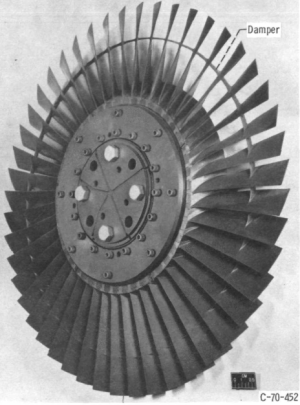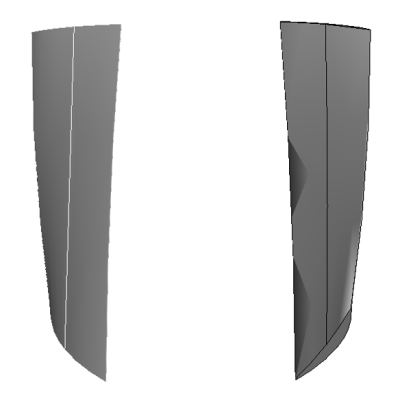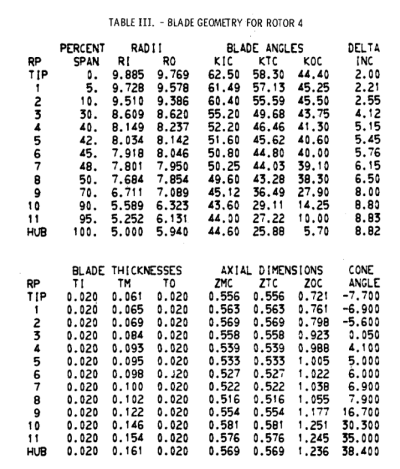Ceci est une ancienne révision du document !
Rotor 4
Original model
Rotor 4 is part of a research program to study the effects of blade row solidity on efficiency and stall margin of an axial-flow compressor rotor. It is one of a series of rotors designed with varying blade solidity achieved by changing the blade chord length : rotor 3 with a tip solidity of 1.3, rotor 4 with a tip solidity of 1.1 and rotor 5 with a tip solidity of 1.5. The results showed that the efficiency and pressure ratio were higher for a rotor with a blade tip solidity of 1.5 than for a rotor with a solidity of 1.1.
Then, another series of tests has been conducted with blade tip solidities of 1.3 (rotor 14), 1.5 (rotor 8), and 1.7 (rotor 12). Tip solidity are being changed by varying the number of blades while maintaining the same velocity diagrams and flow path. These stages were designed such that the tip solidity of both the rotor and stator blades are the same.
- Original technical report [1]:
@TechReport{janetzke1972design, author = {Janetzke, David C. and Ball, Calvin L. and Hager, Roy D.}, title = {Performance of 1380-foot-per-second-tip-speed axial-flow compressor rotor with blade tip solidity of 1.1}, institution = {NASA Lewis Research Center Cleveland, OH, United States}, note = {NASA-TM X-2449, url~: \url{https://ntrs.nasa.gov/citations/19720011348}, 1972}} - Picture :
Useful documents
- PDF of the NASA report : rotor4.pdf
- CSV file of the blade geometry : rotor4_original.csv
Geometry
The geometry of rotor 4 is described in the original NASA report by the following tables. The length are in inches and the angles in degrees.

Aerodynamic design
| unit | values | |
|---|---|---|
| pressure ratio | [-] | 1.8 |
| mass flow | [kg/s] | 29.6 |
| tip speed | [m/s] | 420.6 |
| tip solidity | [-] | 1.1 |
| aspect ratio | [-] | 3 |
| number of blades | [-] | 47 |
| rotative speed | [rad/s] | 1675.51 |
Material properties
Rotor 4 is made of a 200-grade maraging steel
| unité | valeurs | |
|---|---|---|
| alloy | [-] | 18-Ni-200-maraging |
| Young's modulus | [GPa] | 180 |
| density | [kg/m3] | 8000 |
| Poisson's ratio | [-] | 0.3 |
| yield stress | [GPa] | 1.38 |
First three natural frequencies (with clamped root) for the mesh:
- (1B): 1703.3 rad/s / 271.1 Hz
- (2B): 6681.9 rad/s / 1063.5 Hz
- (1T): 8631.9 rad/s / 1373.8Hz
CAD
Modèle original
Le rotor 4 fait partie d'un programme de recherche visant à étudier les effets de la solidité de la rangée d'aubes sur le rendement et la marge de décrochage d'un rotor de compresseur à flux axial. Il fait partie d'une série de rotors conçus avec une solidité d'aube variable obtenue en modifiant la longueur de la corde de l'aube : le rotor 3 possédant une solidité en tête de 1.3, le rotor 4 possédant une solidité en tête de 1.1 et le rotor 5 possédant une solidité en tête de 1.5. Les résultats ont montré que le rendement et le taux de compression étaient plus élevés pour un rotor avec une solidité en tête 1.5 que pour un rotor avec une solidité de 1.1.
Ensuite, une autre série d'essais a été menée avec des solidité en tête de 1,3 pour le rotor 14, 1.5 pour le rotor 8 et 1.7 pour le rotor 12. Ces solidités sont modifiées en faisant varier le nombre d'aubes tout en conservant les mêmes triangles de vitesse et le même trajet d'écoulement. Ces étages ont été conçus de manière à ce que la solidité en tête du rotor et du stator soit la même.
- Rapport technique original [1]:
@TechReport{janetzke1972design, author = {Janetzke, David C. and Ball, Calvin L. and Hager, Roy D.}, title = {Performance of 1380-foot-per-second-tip-speed axial-flow compressor rotor with blade tip solidity of 1.1}, institution = {NASA Lewis Research Center Cleveland, OH, United States}, note = {NASA-TM X-2449, url~: \url{https://ntrs.nasa.gov/citations/19720011348}, 1972}} - Photographie :
Documents utiles
- PDF du rapport de la NASA : rotor4.pdf
- Fichier CSV de la géométrie : rotor4_original.csv
Géométrie
La géométrie du rotor 4 est décrite dans le rapport d'origine de la NASA par les tableaux suivants. Les grandeurs sont en pouces et en degrés.
Caractéristiques aérodynamiques
| unités | valeurs | |
|---|---|---|
| taux de compression | [-] | 1,8 |
| débit massique | [kg/s] | 29,6 |
| vitesse en tête | [m/s] | 420,6 |
| solidité en tête | [-] | 1,1 |
| allongement | [-] | 3 |
| nombre d'aubes | [-] | 47 |
| vitesse de rotation | [rad/s] | 1675,51 |
Propriétés matériau
Le matériau du rotor 5 est un alliage à base de nickel : un acier maraging de grade 200
| unité | valeurs | |
|---|---|---|
| alliage | [-] | 18-Ni-200-maraging |
| module d'Young | [GPa] | 180 |
| masse volumique | [kg/m3] | 8000 |
| coefficient de Poisson | [-] | 0,3 |
| limite élastique | [GPa] | 1,38 |
Fréquences des trois premiers modes (noeuds de la base encastrés) pour le maillage :
- (1B): 1703,3 rad/s / 271,1 Hz
- (2B): 6681,9 rad/s / 1063,5 Hz
- (1T): 8631,9 rad/s / 1373,8Hz


